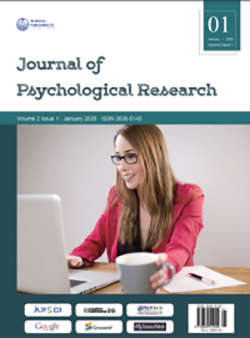-
1541
-
1345
-
1336
-
1329
-
1205
Facial Expression Recognition of Portuguese using American Data as a Reference
DOI:
https://doi.org/10.30564/jpr.v2i1.700Abstract
It is unknown if the ability of Portuguese in the identification of NimStim data set, which was created in America to provide facial expressions that could be recognized by untrained people, is (or not) similar to the Americans. To test this hypothesis the performance of Portuguese in the recognition of Happiness, Surprise, Sadness, Fear, Disgust and Anger NimStim facial expressions was compared with the Americans, but no significant differences were found. In both populations the easiest emotion to identify was Happiness while Fear was the most difficult one. However, with exception for Surprise, Portuguese tend to show a lower accuracy rate for all the emotions studied. Results highlighted some cultural differences.Keywords:
NimStim, Emotions, Facial expression, Facial expression recognition, Facial affectReferences
[1] Biehl, M., Matsumoto, D., Ekman, P., Hearn, V., Heider, K., Kudoh, T., et al.. Matsumoto and Ekman’s Japanese and Caucasian Facial Expressions of Emotion (JACFEE): Reliability Data and Cross-National Differences. Journal of Nonverbal Behavior, 1997, 21: 3-21. DOI: https://doi.org/10.1023/A:1024902500935
[2] Ekman, P.. Universal and cultural differences in facial expressions of emotions. In J. Cole (Ed.), Nebraska symposium on motivation. Lincoln: University of Nebraska Press, 1972: 207-283.
[3] Ekman, P., Friesen, W. V., O’Sullivan, M., Chan, A., Diacoyanni-Tarlatzis, I., Heider, K., et al.. Universals and cultural differences in the judgments of facial expressions of emotion. Journal of Personality & Social Psychology, 1987, 53(4): 712-717. DOI: https://doi.org/10.1037/0022-3514.53.4.712
[4] Ekman, P., Sorensen, E. R., & Friesen, W. V.. Pancultural elements in facial displays of emotions. Science, 1969, 164: 86-88. DOI: https://doi.org/10.1126/science.164.3875.86
[5] Elfenbein, H. A., & Ambady, N. A.. On the universality and cultural specificity of emotion recognition: A meta-analysis. Psychological Bulletin, 2002, 128: 203-235. DOI: https://doi.org/10.1037//0033-2909.128.2.203;DOI: https://doi.org/10.1037/0033-2909.128.2.203
[6] Elfenbein, H. A., & Ambady, N. A.. When familiarity breeds accuracy: Cultural exposure and facial emotion recognition. Journal of Personality and Social Psychology, 2003, 85: 276-290. DOI: https://doi.org/10.1037//0022-3514.85.2.276
[7] Elfenbein, H. A., Mandal, M. K., Ambady, N. A., Harizuka, S., & Kumar, S.. Hemifacial differences in the in-group advantage in emotion recognition. Cognition and Emotion, 2004, 18: 613-629.DOI: https://doi.org/10.1016/j.jesp.2005.10.006
[8] Izard, C. E.. The face of emotion. New York: Apple-ton-Century-Crofts, 1971.
[9] Izard, C. E.. Innate and universal facial expressions: Evidence from development and cross-cultural research. Psychological Bulletin, 1994, 115, 288-299. DOI: https://doi.org/10.1037/0033-2909.115.2.288
[10] Matsumoto, D., Olive, A., & Willingham, B.. Is There an Ingroup Advantage in Recognizing Spontaneously Expressed Emotions? Journal of Nonverbal Behavior, 2009, 33 (3): 181-191. DOI: https://doi.org/10.1007/s10919-009-0068-z
[11] Matsumoto, D.. Culture and Emotion. In D. Matsumoto (Ed.), The handbook of culture and psychology (pp. 171-194). New York: Oxford University Press, 2001.
[12] Matsumoto, D., & Ekman, P.. American-Japanese cultural differences in intensity ratings of facial expressions of emotion. Motivation & Emotion, 1989, 13(2): 143-157. DOI: https://doi.org/10.1007/BF00992959
[13] Matsumoto, D., & Willingham, B.. Spontaneous Facial Expressions of Emotion of Congenitally and Non-Congenitally Blind Individuals. Journal of Personality and Social Psychology, 2009, 96(1): 1-10. DOI: https://doi.org/10.1037/a0014037
[14] Matsumoto, D., Keltner, D., Shiota, M. N., Frank, M. G., & O'Sullivan, M.. What's in a face? Facial expressions as signals of discrete emotions. In M. Lewis, J. M. Haviland & L. Feldman Barrett (Eds.), Handbook of emotions. New York: Guilford Press, 2008: 211-234.
[15] Montagne, B., Kessels, R.P., De Haan, E.H., Perrett, D.I.. The Emotion Recognition Task: a paradigm to measure the perception of facial emotional expressions at different intensities. Perceptual and motor skills, 2007, 104(2): 589-98. DOI: https://doi.org/10.2466/PMS.104.2.589-598
[16] Preacher, K. J.. Calculation for the chi-square test: An interactive calculation tool for chi-square tests of goodness of fit and independence [Computer software], 2001. Available from: http://quantpsy.org
[17] Shioiri, T., Someya, T., Helmeste, D. & Tang, S.W.. Misinterpretation of facial expression: a cross-cultural study. Psychiatry and Clinical Neurosciences, 1999, 53(1): 45-50.
[18] Tottenham, N., Tanaka, J., Leon, A. C., McCarry, T., Nurse, M., Hare, T. A., …, Nelson, C. A.. The NimStim set of facial expressions: judgments from untrained research participants. Psychiatry Research, 2009, 168: 242-249. DOI: https://doi.org/10.1016/j.psychres.2008.05.006
[19] Treese, A. -C.,Brinkmann, M., & Johansson, M.. Picture database of emotional facial expressions, 2003, Report No 87. Retrieved from Saarland University Website: http://psydok.sulb.uni-saarland.de/volltexte/2003/87/
[20] Yuki, M., Maddux, W. W., & Masuda, T.. Are the windows to the soul the same in the East and West? Cultural differences in using the eyes and mouth as cues to recognize emotions in Japan and the United States. Journal of Experimental Social Psychology, 2007, 43: 303-311. DOI: https://doi.org/10.1016/j.jesp.2006.02.004
Downloads
How to Cite
Issue
Article Type
License
Copyright © 2019 Catarina Iria, Rui Paixão, Fernando Barbosa

This is an open access article under the Creative Commons Attribution-NonCommercial 4.0 International (CC BY-NC 4.0) License.




 Catarina Iria
Catarina Iria





